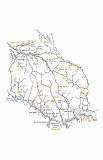Kvalitní cestovní pojištění
do zahraničí i do ČR.
Cestovní pojištění jednoduše, rychle a online na Top-Pojištění.cz s okamžitou platností a se slevou až 50 %.
Nejlevnější cestovní pojištění
na celý rok už od jediné koruny na den.
Jizerské hory (JH)
Jizerské hory: Unit photos | Add photo | Add information
Move on: Bukovec | Černá hora | Černý vrch | Holubník | Jizera | Na kneipě | Polední kameny | Ptačí kupy | Smědavská hora | Smrk | Sněžné věžičky | Věžní skály | Zámky
Related links: Krušné hory | Ještědsko-kozákovský hřbet | Jizerské hory | Krkonoše | Orlické hory | Králický Sněžník | Hanušovická vrchovina | Rychlebské hory | Hrubý Jeseník | Moravskoslezské Beskydy | Hostýnsko-vsetínská hornatina | Javorníky | Novohradské hory | Šumavské podhůří | Šumava | Český les
The Jizerské Mountains are a flattish range in the Krkonoše region, 30 kilometers long and 20 kilometers wide. The northwestern and northeastern parts border with Poland, where it separates the Frýdlantský promontory from Czech interior. The highest peaks on the Czech side are Smrk (1,124 meters above sea level) and Jizera (1,122 meters above sea level), the peaks in Poland are a little higher, Wysoka Kopa (1,126 meters above sea level) and Sine Skałki (1,125 meters above sea level). The geological composition is mainly granite; of significance is the massif Bukovec, which is comprised of igneous rock, namely basalt. This range is amid a terrain of mountainous block-faults. The elevated Jizerskohorská fault blockis slightly angled to the south, which is the reason for the differences in the northern and southern slopes. While the northern face is steep, compact and considerably high (300–400 meters), the southern slope is mild, divided into separate ridges by the flowing of water.From a climatological viewpoint, the mountains are significant for the high total amount of rainfall, in some places reaching even 1,500 millimeters per calendar year, making this the most humid area in the Czech Republic. The environment of the Jizerské Mountains has been damaged by pollutants from nearby power stations in Germany and Poland, in some areas of the range the invaluable vegetation has almost died out (for example, in the Prales Jizera Nature Reserve). The absence of high-grown forests indirectly damages numerous peaty moors, which are partially drying out. Out of the entire CHKO Jizerské Hory (protected landscape area), the least damaged area seems to be the steep northern face, overgrown with semi-natural scree-forests. (Jizerskohorské Bučiny National Nature Reserve). In winter there is enough snow and the Jizerské Mountains are a cross-country skiing paradise. There are tens of kilometers of conditioned trails and modest terrain. And, even for summer touring, the Jizerské Mountains’ number of trails, lodging and restaurants is ample. For Thousanders, there are 13 peaks, mostly interesting, with rocky summits and beautiful views.



